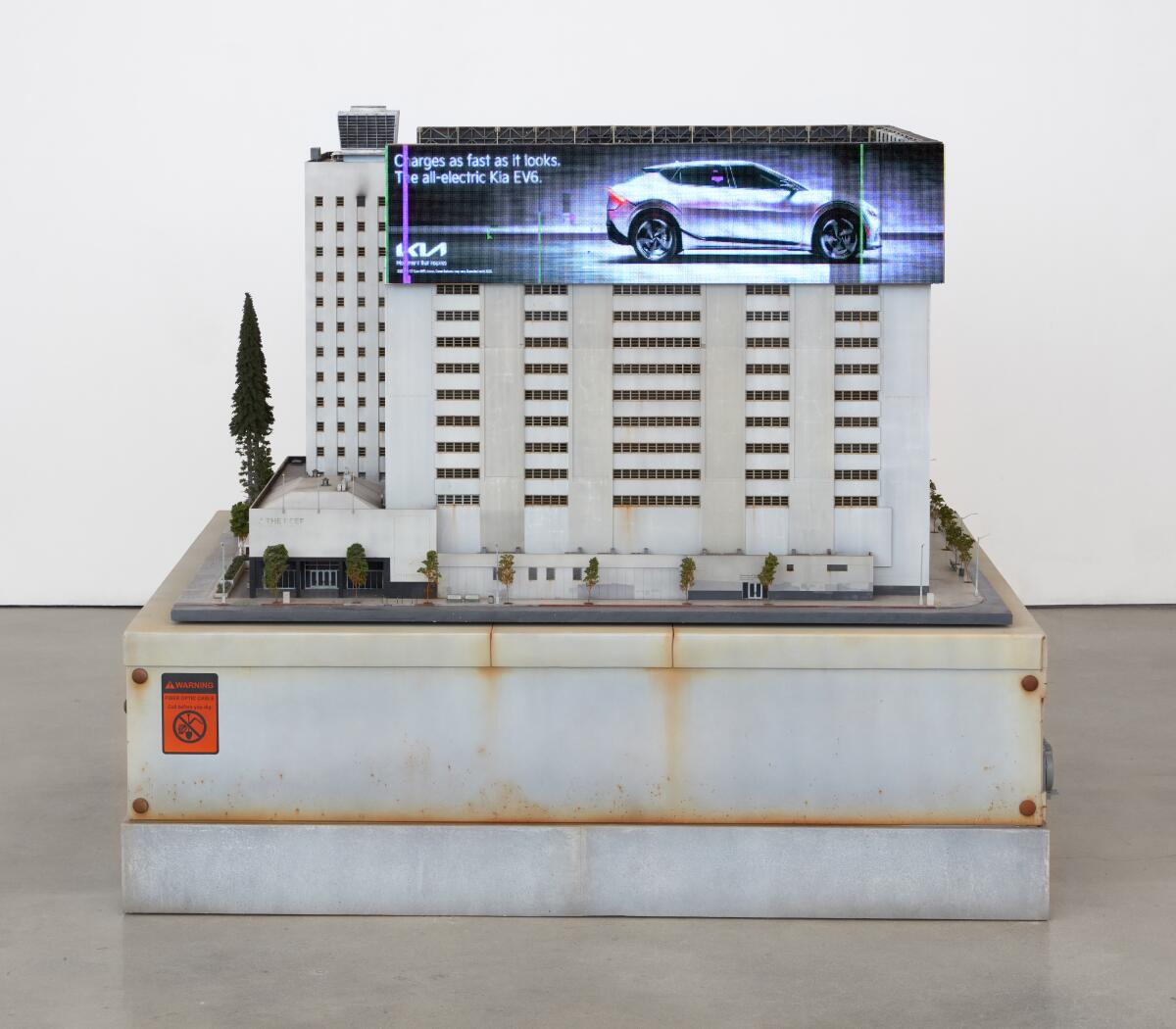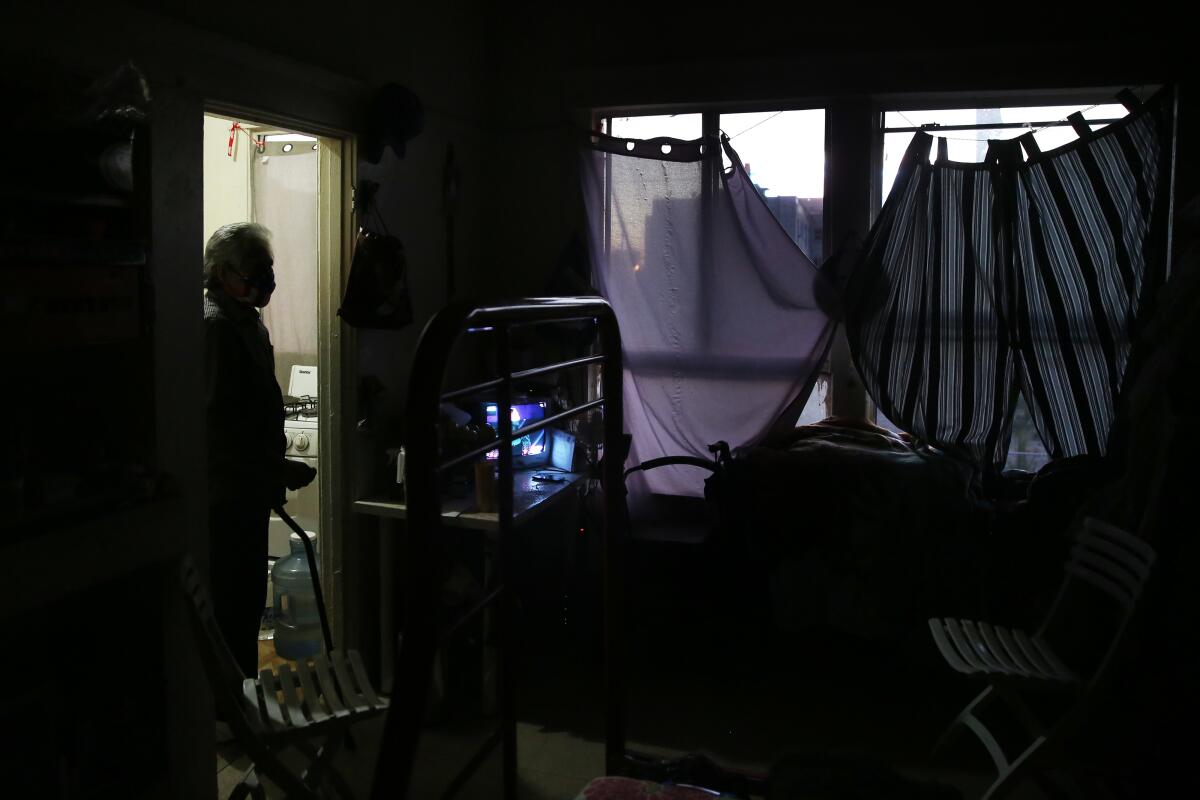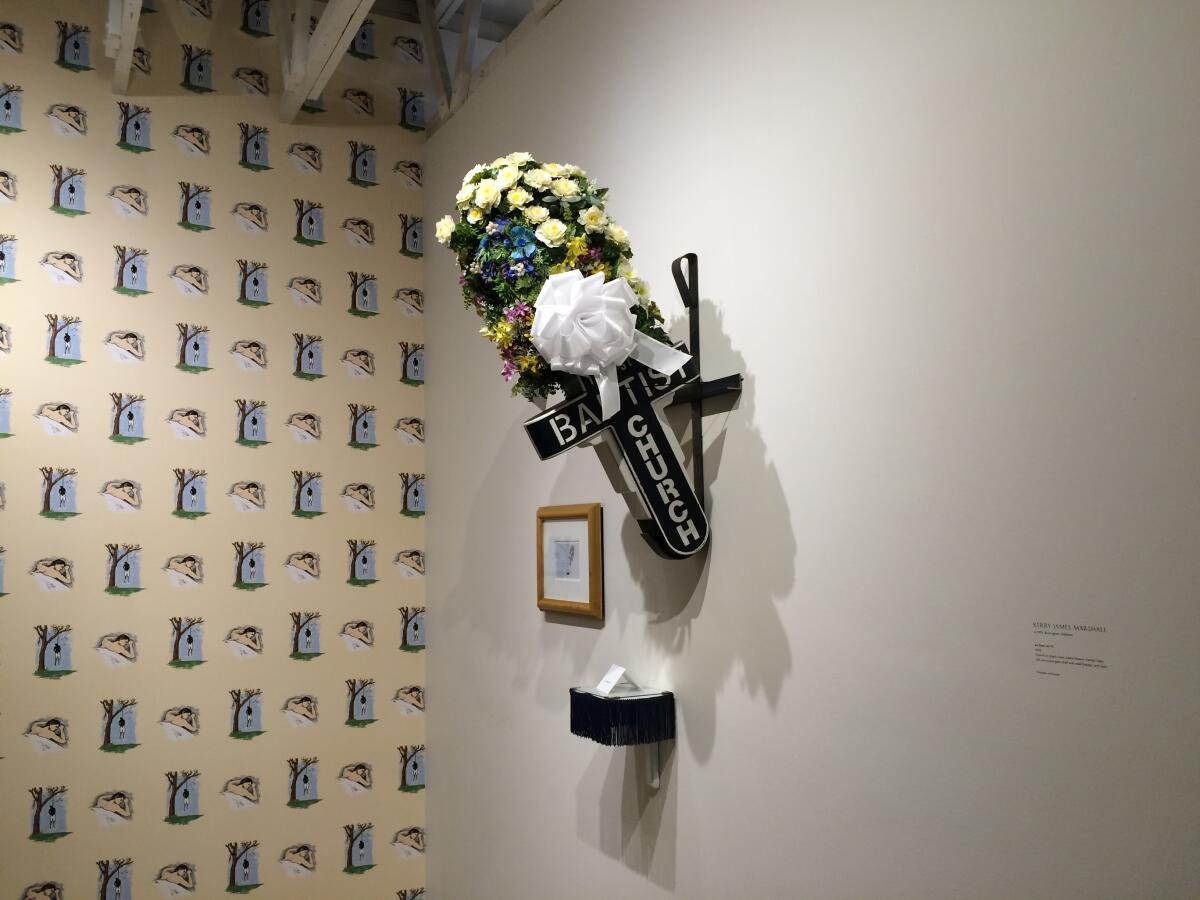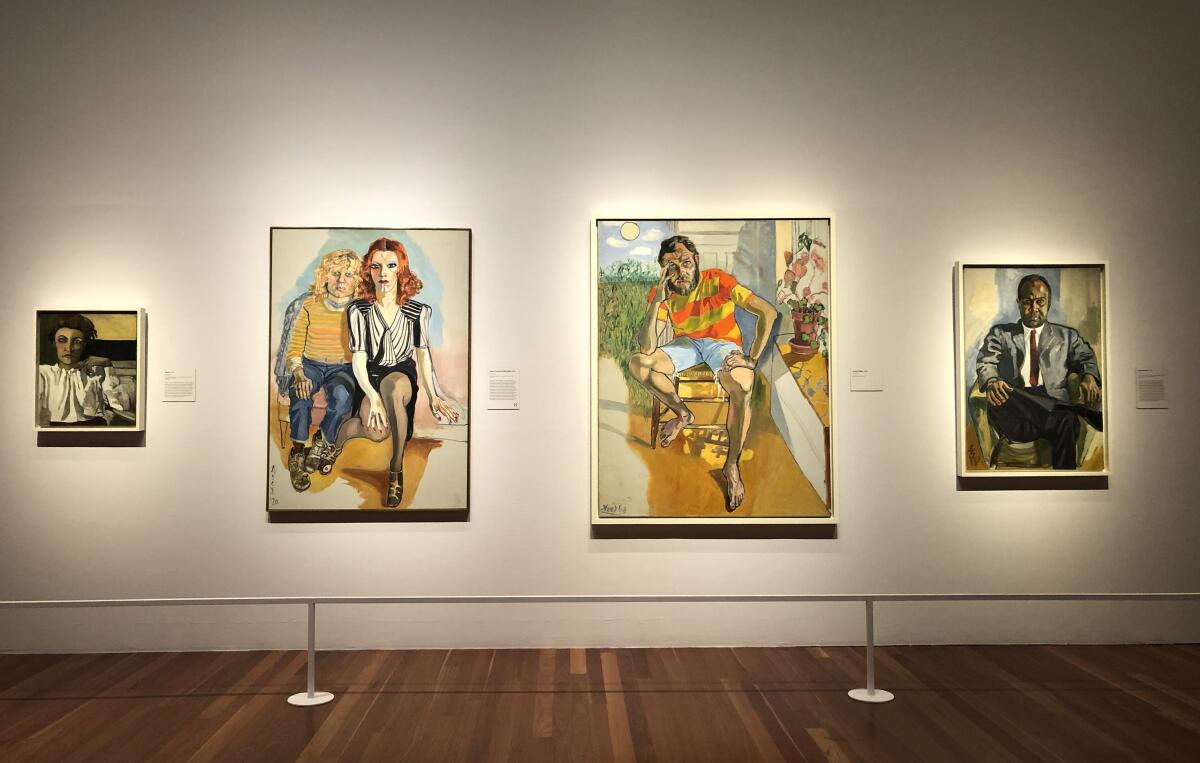This Sayre Gomez sculpture is a monument to the worst habits of L.A.’s City Council

- Share via
So in addition to flooding and hellfire, climate change is going to make pollen season worse. (CCing all producers of NFTs.) I’m Carolina A. Miranda, arts and urban design columnist at the Los Angeles Times, and I and my angry sinuses have a culture newsletter for you:
The most garish building in L.A.?
If you were to build a monument to the Los Angeles City Council, what would it be?
Perhaps it would look like the Reef. I’m talking about that dour 12-story building downtown just south of the 10 that is wrapped on three sides by staggeringly ginormous LED advertising billboards that no doubt have seared countless eyeballs between here and Mars.

The building, built in 1957, initially served as home to the Los Angeles Home Furnishing Mart, where a cooperative of furniture companies could display their wares. In the new millennium, however, the property began to change hands, and by 2012 it was controlled by Avedis and Ara Tavitian, a pair of medical doctors turned real estate investors who had big — big — plans to turn the building, along with its adjacent lots, into a mixed-use skyscraper mega-development called Broadway Square Los Angeles. This would include 1,444 apartments and condominiums, a 208-room hotel and, of course, plenty of retail. After protests by neighborhood groups — this area is one of the poorest in Los Angeles — the developers agreed to put $15 million into an affordable housing fund controlled by Councilman Curren Price, who represents the district.
Needless to say, the development has yet to happen. But the company was allowed to saddle the Reef with those three massive LED advertising billboards, which each measuring about 55 by 245 feet. As my colleagues David Zahniser and Emily Alpert Reyes have reported in the past, this involved all kinds of workarounds that came courtesy of Price’s office: The councilman allowed the signs to be twice as big as recommended by the planning department, and their images change every eight seconds — instead of the one-minute interval recommended by the city.
Three months after these exemptions were approved, the Tavitians’ real estate company donated $75,000 to a political action committee working to reelect Price. Meanwhile, residents in the neighborhood say the glare from the light is so intense it has affected their ability to sleep.

The Reef is one of those urban monstrosities that sends me into a blinding rage every time I drive past it (really, it’s blinding), so I was enthralled to see it reproduced — down to its last garish detail — by artist Sayre Gomez in his solo show at François Ghebaly Gallery. The painter and sculptor has re-created the building to scale, at a height of nearly 5 feet, complete with LED billboards flashing a rotating array of advertisements.
The reduced size makes for a truly bizarre and uncanny sight — highlighting its grim facades, its willfully homely form and the mammoth scale of its LED billboards, which have all the design grace of the drunk guy wearing a lampshade at the party.
It is Los Angeles on those days when it’s been beat hard with the ugly stick.

Gomez, who hails from Chicago but has lived in Los Angeles since 2006, says that, in creating the piece, he was interested less in the building’s enraging backstory than what it represents visually and historically: an industrial/commercial structure from the 20th century that has been reinvented for the 21st as a beacon of the digital.
“The use-value of the building has shifted dramatically away from its original purpose,” says Gomez. “It’s almost this gestalt manifestation where you literally have these two things that are colliding: You have this old history being completely trampled by this very contemporary thing. The building’s function is reassigned to pedestal.”
Make the most of L.A.
Get our guide to events and happenings in the SoCal arts scene. In your inbox every Monday and Friday morning.
You may occasionally receive promotional content from the Los Angeles Times.
The sculpture, which is titled “Halloween City,” is the namesake piece for the artist’s show at Ghebaly, which examines the evolving nature of urban space and the ways in which those are mediated.
The theme was inspired by an empty big box store in Gomez’s neighborhood that every year features a pop-up Halloween shop called Halloween City. “You have this husk of a former kind of consumerism sitting there almost like a tombstone,” he explains. “And every year Halloween City sets up shop. It’s almost like a parasite.”
In addition to the namesake sculpture, the show includes Gomez’s eerie paintings of urban landscapes and of cheap commercial signage — the sort that is left to fade in windows and doorways, beckoning with flashing LED and blinking neon. On first impression, you might believe that his paintings are studded with functioning light, but it is all paint: Gomez has the ability to draw the most uncanny urban glow out of his palette.
Ultimately, it’s an anti-picturesque view of L.A. (and its governance) — the city as it often is, not as we wish it to be.
Do not miss.
Sayre Gomez, “Halloween City,” is on view at François Ghebaly Gallery through March 27.
Opera troubles
It’s been a week at Long Beach Opera. On Monday, as my colleague Jessica Gelt reports, the company announced the cancellation of “Stimmung,” its first show of the 2022 season after director Alexander Gedeon resigned a little more than a week before the show was set to open. His departure was one of three high-profile resignations — which also included Derrell Acon, associate artistic director, and Elijah Cineas, manager of education — over concerns about “workplace environment and issues of equity and diversity.” In a statement to The Times, a spokesperson for LBO wrote that the board had hired an investigator to look into the allegations, and the “investigation is ongoing.”
Enjoying this newsletter? Consider subscribing to the Los Angeles Times
Your support helps us deliver the news that matters most. Become a subscriber.
In a follow-up report, Gelt delved more deeply into the allegations, reporting on a letter submitted to the board of directors that alleged a “culture of misogyny” and “racial tokensim” — a copy of which was posted to Facebook by the Black Opera Alliance. The resigning members had tendered their resignations in December with the idea that they would complete their artistic work on the project before departing. But Gelt writes that in a subsequent Facebook post, “Gedeon made clear that he felt the situation had become untenable.”
Visual art report
It’s also been a week at the Underground Museum, which announced that it was closing “until further notice.” In an Instagram post, artist and co-founder Karon Davis stated that running the space she helped launch with her late husband, painter Noah Davis, and his brother, video artist Kahlil Joseph, had been “an incredible journey” but one that had not allowed her to “grieve his loss privately or take the time needed to heal.” Deborah Vankin reports that this will bring to a conclusion the short-lived tenures of co-directors Meg Onli and Cristina Pacheco, who had just joined the organization in the fall.

With the refugee crisis in Ukraine reaching epic proportions, Vankin also reports on a timely exhibition inspired by the refugee experience at American Jewish University. Jenny Yurshansky‘s solo show, “A Legacy of Loss: There Were No Roses There,” explores the journey made by her parents when they fled Soviet-era Moldova in 1978. “I’d gotten an artist grant from Asylum Arts to take my mom back to Moldova for the first time since fleeing,” Yurshansky tells Vankin of the exhibition’s origins. “I wanted to explore this theme of what it means to be a refugee, studying my own family as a case study.”
Arts and Ukraine
It’s been another devastating week for the people of Ukraine as Russian missiles continue to pummel city centers. On Wednesday, a Russian airstrike hit the Drama Theater of Mariupol, where hundreds of people had taken shelter. As Washington Post theater critic Peter Marks notes in a column, in addition to the human toll the bombings have taken, it shows that the “temples of culture,” sites that offer “soul-nourishing mainstays of civic life,” will not be spared by the Russians.
That same day, Bolshoi star ballerina Olga Smirnova announced that she was leaving the famed Russian dance company to join the Dutch National Ballet. “I never thought I would be ashamed of Russia,” she wrote of her decision on the social media app Telegram.

Other resignations continue apace: Francesco Manacorda has resigned as artistic director of the V-A-C Foundation in Moscow due to the conflict, as has Vladimir Opredelenov, deputy director of the Pushkin Museum, which is also based in Moscow. Opredelenov had been at the museum for 19 years.
Plus, the Tate in London has cut ties to two billionaires with connections to Putin. And some in the art world are calling for a boycott of the Russian-owned auction house Phillips.
Correspondents Max Bearak and Isabelle Khurshudyan of the Washington Post report on the effort to secure art around Ukraine. While some cities, like Lviv and Kyiv have had more time to prepare, others have not — and at risk are heritage and monuments that date back to the 11th century. As they write: “The windows of Kharkiv’s main art museum have been blown out, subjecting the 25,000 artworks inside to freezing temperatures and snow for weeks. The city’s opera and ballet theaters were extensively shelled.” Be sure to click through. The photo of a monument of the Duke of Richelieu surrounded by sandbags is absolutely surreal.
You can find The Times’ full coverage of Ukraine at this link.
On and off the stage
Benjamin Benne’s play “Alma,” which is receiving its world premiere at the Kirk Douglas Theatre in Culver City, tells a rich and poignant story of a mother and daughter in the wake of the election that put Trump in office. Alma is an undocumented immigrant working low-wage jobs, but she aspires to more for her high school daughter, Angel, who is brushing up for the SAT. “A lot of pieces for the white gaze tend to focus more on people’s pain and suffering,” Benne tells The Times’ Ashley Lee. “While I want to be true to the struggles people have, especially in situations like Alma and Angel’s, I hope that we also get to see the multiplicity of the love and care they have for each other.”

Times theater critic Charles McNulty checked out playwright Lindsay Joelle’s “entertaining bromance,” “Trayf,” which is currently on stage at the Geffen Playhouse’s Audrey Skirball Kenis Theater. The play tells the story of two young Hasidic Jews from Brooklyn who become friendly with a “lost soul” named Jonathan during their peregrinations in a mitzvah van, in search of Jews who have lost touch with their faith. Their interactions offer each of them views into the others’ worlds. “The dynamics of this trio,” writes McNulty, “are observed by Joelle with a lively wit and genial wisdom.”
Plus, Margy Rochlin reports on how L.A.’s beloved Bob Baker Marionette Theater survived COVID — by moving at warp speed. They staged Zoom puppet-making sessions and had puppets serve as wedding officiants. And, “borrowing a concept from the New Deal era, when traveling puppet shows were commonplace, the troupe installed curtains and built fold-out scenery in a 15-foot Isuzu box truck donated by Bob Baker fans Greg and Eli Park,” writes Rochlin. “Soon after the initial lockdown was lifted, the troupe was tooling around L.A. in its ‘Marionette Mobile.’”

Design time
Architect Diébédo Francis Keré became the first African and the first Black person to win the Pritzker Architecture Prize this week. It’s a socially and environmentally minded choice: Kére is best known for his designs of simple yet elegant educational facilities in his native Burkina Faso that make the most of passive ventilation, natural light and local materials such as clay. “Francis Kéré’s work,” reads the jury citation, “shows us the power of materiality rooted in place.”
Meanwhile, in Los Angeles: Times classical music critic Mark Swed reports on the revamped design for a new performance and rehearsal space for the Colburn School in what is currently a very unglamorous and very steep parking lot downtown at the corner of Olive and 2nd streets on Bunker Hill. Designed by a team at Gehry Partners, the plan includes a 1,000-seat concert hall in the round (inspired by the firm’s Boulez Saal in Berlin), allowing an audience a 360-degree perspective of performances, as well as dance rehearsal and other educational spaces staggered over the hillside.
Swed says this adds a new type of performance space to L.A.: “[Frank] Gehry designed a full-size orchestra pit that can hold up to 70 players when used, making this the perfect size for Baroque opera, Mozart, 20th century chamber opera and the experimental work that excites today’s young composers,” he writes. “Dance in the round becomes an intriguing possibility.”

I popped over to the (overproduced) news conference for the design’s unveiling on Wednesday morning. The design for the performance space is remarkable: steep tiers of circular seating that embrace a central performance space finished with humble plywood — all under a ceiling that evokes a series of undulating white clouds.
Also really intriguing is a proposal for the public space around the building. Namely, the design calls for shutting down a tiny stretch of 2nd Street to create a public plaza on the building’s western flank that would serve as both pedestrian corridor and outdoor performance space. Currently this sliver of street clings precariously to a hillside over the 2nd Street Tunnel. It is narrow, features sidewalks on only one side and is so steep that most vehicular traffic and pedestrians avoid it. Turning it into a public plaza is an infinitely better use of this sad piece of thoroughfare — a vestige of the urban planning disaster that has been Bunker Hill.
I was underwhelmed, however, by the design of the proposed building’s exterior, which is blocky and generally unremarkable — a structure that seems as if it is still trying to figure out how to contort itself to the steep grade and the massive structures all around (which includes Gehry’s behemoth Grand LA to the north). The architects say they hope to gussy up the plain facade with a skin of pink titanium. But I wouldn’t be placing any bets on that.
Can you guess two of the world’s top five producers of titanium?
Answer: Russia and Ukraine.
Essential happenings
A bit of Wagner, Mendelssohn and Brahms courtesy of the Los Angeles Chamber Orchestra, a family festival marking the Iranian New Year holiday Nowruz, which is Sunday, and a performance by the Martha Graham Dance Company — those are just a few of the seven best bets for the weekend compiled by listings coordinator Matt Cooper.
During a jaunt to San Francisco last week, I paid a visit to Diego Rivera’s “Pan American Unity” mural currently on view at SFMOMA. It was Rivera’s last U.S. mural, painted in 1940, and is as much a cinematic homage to San Francisco and cultural solidarity between North and South America as it is a harbinger of the conflict that was already underway in Europe. The mural, which belongs to the City College of San Francisco, is in the museum’s free Roberts Family Gallery on the first floor — a good place to hang out on a bench and drink it all in. The best part is that you’ll have plenty of time to see it: It’s on view into 2023.
My main reason for heading north, however, was to go marinate in “Alice Neel: People Come First” at the de Young Museum — an absolutely beguiling collection of portraits that capture the artist’s lovers, friends, neighbors, queer cultural figures and feminist and civil rights activists. The range is astonishing, and so is her depiction of them: flesh and blood humans evoking boredom, pain, strength, ambivalence and expectation. As Sarah Hotchkiss wrote of the show for KQED: “Neel was a radical — both for the way she lived her life, and for what and how she chose to paint.”
Especially engrossing to me were Neel’s sympathetic renderings of pregnant women and an absolutely dire depiction of a public hospital’s maternity ward that is making me glad I’ve never had to give birth. (Sex is all over art history; birth, not so much.) In combination with the Rivera murals, Neel’s show makes it a great time to road trip to SF — especially since this is the third and final stop of Neel’s show. “People Come First” is on view through July 10.

Passages
Hiram Maristany, a photographer who chronicled New York’s Spanish Harlem “from the inside out,” is dead at 76.
In other news
— Iraq’s National Museum has reopened after a three-year hiatus.
— A violent man stabbed two visitor services employees at MoMA in New York last week. Although acts such as these are rare, the news has institutions reviewing their security policies.
— How crypto mining could rattle Texas’ shaky power grid and raise everybody’s utility bills in the process.
— The 2022 Academy Museum gala to honor Miky Lee, Steve McQueen and Tilda Swinton.
— In Bakersfield: Architectural studio Page & Turnbull is working on resuscitating the last Woolworth lunch counter.
— In case you’re looking for a high-maintenance house: There’s a Frank Lloyd Wright house for sale in Atherton for a cool $8 million.
And last but not least ...
Because it’s been that kind of week: Here’s a Frenchie in a bee suit.
The biggest entertainment stories
Get our big stories about Hollywood, film, television, music, arts, culture and more right in your inbox as soon as they publish.
You may occasionally receive promotional content from the Los Angeles Times.




